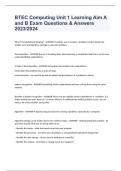Exam (elaborations)
BTEC Computing Unit 1 Learning Aim A and B Exam Questions & Answers 2023/2024
- Course
- Institution
BTEC Computing Unit 1 Learning Aim A and B Exam Questions & Answers 2023/2024 What is computational thinking? - ANSWER-It enables you to analyse a problem, break it down into smaller parts and identify a strategy to solve the problem. Decomposition - ANSWER-the act of breaking down (decompo...
[Show more]



